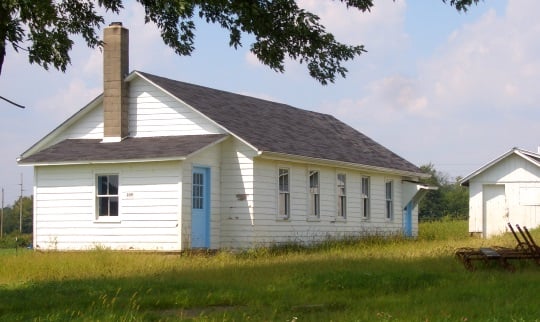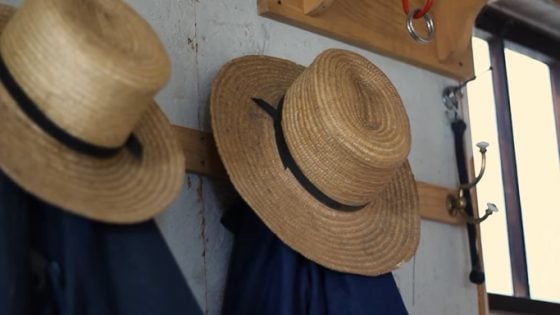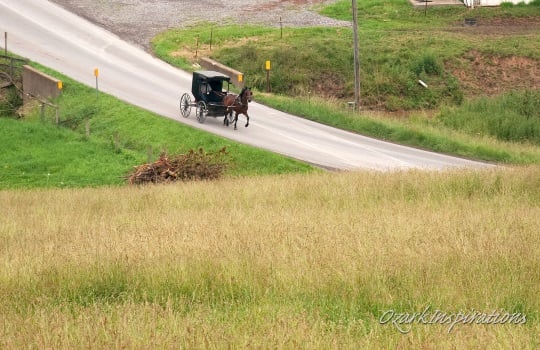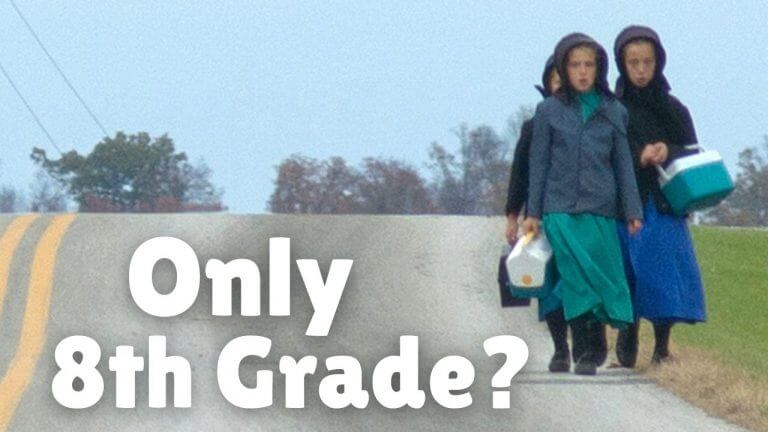15 Ways Amish Schools Differ From Public Schools
For the start of the school term a few weeks ago, Rebecca Miller shared with us 5 things children learn in Amish schools (not found in books).
Today she compares Amish schools with their public counterparts, and shares 15 ways they are different.

It’s worth noting here that quite a few Amish parents do choose to send their children to public schools.
Some Amish parents prefer public schooling to Amish parochial schooling, for reasons including exposure to non-Amish children and teacher background.
But the majority do send their children to privately-run schools taught by Amish teachers. Here are 15 reasons why, from an Amish perspective.
15 Contrasts Between Amish Schools and Public Schools
Amish schools are run much like public schools were up until the 1950s. It’s the public education system that has changed, not the Amish schools. So what are some of these changes that have taken place in public schools?
Here’s a list of 15 contrasts adapted from a Teachers’ Meeting booklet. I don’t know who came up with this list originally, so I’m taking the liberty to revise it and add a few thoughts of my own.
Though since I’ve had no involvement in the public school system other than as an observer, I can only speak for our Amish parochial schools.
1.
AMISH SCHOOLS – are operated by the parents without an administrative bureaucracy.
PUBLIC SCHOOLS – are operated by professionals with an administrative bureaucracy.
In an Amish school the parents hire and pay the teacher, pay for the books and supplies, and keep up the grounds. They along with the teacher make all the decisions.
2.
AMISH SCHOOLS – train youngsters to stay within the community.
PUBLIC SCHOOLS – train youngsters to get ahead in life.
Amish children develop strong connections with their classmates and teachers, because of the close-knit setting and broader connection to the community at large, that are far reaching and give a sense of security and belonging within their community at a young age.
3.
AMISH SCHOOLS – pick teachers because of their Christian examples.
PUBLIC SCHOOLS – pick teachers because of their ability and training.
It is recommended to choose a teacher who is a good example in faith and lifestyle. Sadly, this isn’t always the case. The children learn much by their teacher’s example.
4.
AMISH SCHOOLS – have teachers who are generalists in all subjects.
PUBLIC SCHOOLS – have teachers who are specialists in subjects.
An Amish teacher needs to teach all subjects for all grades from one through eight, therefore a lot of study is needed.
5.
AMISH SCHOOLS – value cooperation and humility.
PUBLIC SCHOOLS – value competition and pride in achievement.
Our schools couldn’t run without these two vital ingredients. Teachers and pupils (as well as their parents) must be able to work together in humility to have a good school.
6.
AMISH SCHOOLS – favor group identity.
PUBLIC SCHOOLS – favor individual expression.
To the Amish “Our People” and “Our Way of Doing Things” are still important. You can have your own personality, but you don’t try to be different–just to be different. In public school there is much more opportunity for children to show individual expression in dress and behavior.
7.
AMISH SCHOOLS – are run on a human scale.
PUBLIC SCHOOLS – are run on an organizational scale.
There is a lot of family involvement and connection between school families. Parents, children, and teachers are connected outside the classroom, as well, in such social events as weddings, funerals, church, and other gatherings. Whereas in public schools teachers may have very little or no involvement in the child’s life outside the classroom.
8.
AMISH SCHOOLS – stress drill accuracy and proper sequence.
PUBLIC SCHOOLS – stress speed, variety, and freedom of choice.
It is important to us that our children learn to work neatly and accurately in the proper order of the day’s assignments.
9.
AMISH SCHOOLS – favor correct knowledge.
PUBLIC SCHOOLS – favor critical thinking.
Memorization, the “right answer”, and proper spelling and grammar are considered very important. Critical thinking suggests, the exact answer might not be as important as how they think through their answer.
10.
AMISH SCHOOLS – rank penmanship high as a skill.
PUBLIC SCHOOLS – rank penmanship low as a skill.
Neatness, easy read-ability, and correct letter formation are deemed more important than unique letter formation. Many public schools are considering dropping the art of cursive writing altogether.
11.
AMISH SCHOOLS – see the child as a future Amish person with a soul.
PUBLIC SCHOOLS – see the child as a citizen with an intellect.
We aren’t only concerned about the child’s education, but also about his soul. Teaching spiritual and moral values, integrity, and honesty are more important than just book learning. Still we want them to get a good education.
12.
AMISH SCHOOLS – hire teachers only from the plain community.
PUBLIC SCHOOLS – hire teachers from diverse backgrounds.
Amish children are taught by an Amish teacher with a sense of Amish behavior, morals, and dress. A public school teacher might be from an entirely different cultural background and children may pick up dress ideas the parents aren’t comfortable with.
13.
AMISH SCHOOLS – stress memorization.
PUBLIC SCHOOLS – downplay memorization.
Besides doing Bible memory verses, we also memorize the times tables, formulas, equivalents (ex. 1 gal. = 4qt.), the presidents, states and capitals, counties of our state, poems, and songs.
14.
AMISH SCHOOLS – reject technology.
PUBLIC SCHOOLS – embrace technology.
The only person with even a calculator is the teacher. There might be a copier in some schools, but even word-processors are discouraged. I know of only a few schools that have a telephone. It’s definitely not the norm.
15.
AMISH SCHOOLS – believe the Bible reveals the Truth.
PUBLIC SCHOOLS – search for truth.
We have Bible stories in the morning, sing Christian songs, and memorize Bible passages. We believe the Bible to be the divinely inspired Word of God. And hopefully that can be passed on to our children.
In closing I would like to say we do not consider either school system to be perfect and we realize not all the contrasts are positive or negative. This article was merely written to show the differences in both systems (from an Amish perspective).
These are things parents in this community might consider when deciding which school system they want their children involved in. Hopefully it can also help answer some questions people might have had about our parochial school system.






another great contribution
I really enjoyed reading this. It’s very objective. I feel differently about the term critical thinking, but the public school does indeed stress that how you think through an idea is more important than what answer you arrive at. I use the term critical thinking here in our ministry with young people who are reading the Bible for the first time, and in learning responsibility and having a respectful cooperative attitude, I want them to know why and to joyfully live out the truth of their relationship with Jesus, both in devotion, their work and their relationships with other people. My place is a bit different simply because the young people that I work with are not from an Amish or Mennonite background and are not well accepted by those who are. So in the end they aren’t really able to be included in the community aspect of things. But seeing them come to know Jesus and grow in Jesus and apply the Word of God to their living and be set free from the bondage of sin and healed from various hurts is the greatest blessing in all of my life.
Not all that different
Both Amish and secular education:
* are agents of socialization within their respective environments.
* end with eighth grade competencies (functional within, but unable to question the status quo).
Because of an increasing diversity within society, public schools had to accommodate. Having a largely homogeneous community and widespread groupthink, Amish schools face fewer challenges.
Anyone interested in understanding the intended purpose of American public education should acquaint themselves with John Taylor Gatto’s The Underground History of American Education.
The battle over the purpose of public schools is largely responsible for the rise of charter schools and similar voucher schemes.
While critical thinking is fashionable in public education theory, it is perceived as a threat by businesses only interested in hiring employees that show up on time, do what they’re told, and don’t ask any questions.
Sameness
I agree that public schools are agents of socialization and tend to create conformity as opposed to a capacity to challenge the status quo, but suggesting they’re like Amish schools in that respect is a problem.
Access to information is a big difference. Exposure to the arts is another. Fiction that has relevance to ones life is another.
Dr. Kraybill writes in “The Riddle of Amish Culture” that Amish education “restricts consciousness.” I think of Kraybill as one of those arbiters of neutrality that always err on the side of not being reasonably critical. At the risk of getting the party started, or taking a cue from Fran, there are other words that could be used other than “restricting consciousness.” But seriously, Amish education is one of those issues that need more definition. Karen Johnson Weiner writes that there is no available evidence to determine how Amish schools are doing. She is also guilty here of erring on the side of not being reasonably critical. She could say that Amish schools are left to wander into the abyss of ignorance, but relativism is so fashionable when addressing Amish issues.
Amish/Public school differences
Thanks for sharing this important information re:the differences between Amish and public schools. I hope you and your scholars will have a wonderful school year! Blessings, Carol
Schooling
When the Amish moved into my hometown area they went to public school. This is before the Yoder/Wisc decision to permit the Amish to have their own schools. At that time you went to school until you were 16 because law mandated it. One day an Amish girl named Millie burst into tears and was asked, What’s wrong? Her answer was, My 16th birthday is coming up and my dad is making me quit school. Millie loved school but by the age of 16 had learned way more than was necessary to function in Amish life. I’ve always wondered if those public instructed kids who are parents, and now grand parents, shared some of that knowledge with their “scholars” as they are called. We’ve all heard a story from someone be it a parent, grand parent, friend or neighbor that would tell us a story about, When I in school….and the story would unfold. In our culture a spark might be ignited. In Amish culture that spark would be snuffed out. If you have a desire to learn “more” you know what you have to do…leave.. and the consequences of it all.
As Maudie says in the Budget , Make it a good day.
That was really interesting. My thoughts go to my own children who go to public school. I realise the reasons they aren’t allowed to continue but can’t help but wonder what they might have to offer to their own people and those of us out here? Could one of these children be the one to help find a cure for cancer Or something related? Unfortunately, we will never know. Just a thought.
Interesting! I will pass this on to my public school teacher daughter.
I went to “parochial” school, too (Catholic school, 12 years), and we, too, were taught many similar “values”/lessons (memorizing the multiplication tables, cursive writing–Palmer Method, learning about religion, the bible, 10 commandments, singing hymns), but we also learned what mankind generally considers “the truth”–which was learned through the ages practicing “sciences” like archaeology & paleontology, astronomy,etc., and arriving at “truth” (often changing as we learn more)using the scientific method.
As was a common saying a few decades ago, “a mind is a terrible thing to waste.” Not that the Amish 8th grade education is the true “end” of their education by any means, but Beckysue has a valid point.
Alice Mary
9.
AMISH SCHOOLS – favor correct knowledge.
PUBLIC SCHOOLS – favor critical thinking.
Memorization, the “right answer”, and proper spelling and grammar are considered very important. Critical thinking suggests, the exact answer might not be as important as how they think through their answer.
~~~~~~~~~~~~~~~~~~~~~~~~~~~~~~
I must disagree with this one.
Today public schools teach ‘critical thinking’ only as far a required to pass the ‘Standardized Testing’ and NOT ‘critical thinking’ as it applies to the ‘Real World’.
I see today to many high school graduates who ‘Can Not Make Change’, you ask them your total was $0.88 and you gave them $1.00 how much change are you to receive. You are answered with a ‘Blank Look’.
~~~~~~~~~~~~~~~~~~~~~~~~~~~~~~
I was hopping to teach the following classes to your home school groups in Mineral & Hampshire County, WV & Garret & Allegany County, MD;
Semester 1 Personal Financial Management
Semester 2 Entrepreneurship and Business Accounting, Starting and Running a Business
But there is only a small number of homeschool students and none of the parents were interested.
~~~~~~~~~~~~~~~~~~~~~~~~~~~~~~
Now I see the Amish children receive these lessons everyday in spoken words and example by watching their parents run the farm or other business, then after 8th grade go on to their apprenticeship and this is again reinforced.
Homeschool
Do many Amish homeschool? This is a very interesting comparison of Amish and public schools, but I’ve always wondered if homeschooling is growing in popularity among the Amish as quickly as it is among the rest of the world?
Thanks 🙂
Hi Renata
We have several Amish friends and to the best of my knowledge none of their children were ever home schooled. If you didn’t go to school you wouldn’t get much of a break from the work at home! You have duties before and after school, so time away would be a good thing. Their schools are an important factor to their community. Parents take turns bringing in hot lunch. Maybe a friend was driving by and decided to just stop in at school and say hi, and listen to the lessons going on. When there’s a program there’ll be plenty in attendance. I heard those same stories from my own parents and their time spent in a country school. My mom was 11 in 1929 when they moved to town and she thought she’d be way behind the town kids….not at all…she was ahead! Some of those “Good old days” really were good!
Thanks
Thanks for your reply Terry. It is very interesting and it makes a lot of sense with the farm work that includes the children. I love how you describe the school as being a central part of the community!
home school, the good old days
I think home school is considered subversive in the Lancaster settlement to the point where it is referenced in the ordnung. It is considered being too independent. It also may be in part because home schooling is dominated by Fundamentalist Christians in Lancaster and participating in the movement would expose Amish parents to their influence. There is a long history of proselytizing the Amish from Fundamentalist Christians, some of it in ways that creates a good bit of tension.
On the good old days, the education your mom experienced between the country school and the town school would’ve been under the same curriculum, teacher certification, and text books. In other words, there would’ve been no difference. This is not the circumstance regarding the Amish schools today and their non Amish counter parts. For example, I’ve grandchildren attending a relatively small religious parochial school. They’re not Amish, but in world view they’re not all that far apart. Yet the approach to academics is light years apart. One of my grandchildren was developmentally falling behind. Her school was able to tap into the public school system to utilize a speech therapist. The difference it made for her was amazing. Before speech therapy, she was starting to avert her eyes and generally look down or away when speaking. Post speech therapy, she would beam at you, big smile, eyes meeting yours. Even though the remedial efforts took awhile, the crippling effects were dramatically minimized.
It is possible that some Amish schools, like in Ohio where there is a greater degree of integration, might function like that, but the percentage that do is small.
Homeschooling is not common among Amish
Yes, as noted elsewhere it’s not common. I’ve bumped into a couple of Amish homeschool families here and there but it was always an outlier. I asked an expert about this once and she told me that homeschooling does not promote community. Makes sense as it sort of strikes at a chief Amish value.
School
When you look back in our own history of country schools, it runs along the lines of the Amish. As I stated in my earlier post about my parents stories, school really was a huge part of the community. Rural life years ago didn’t have a lot of opportunities for fun off the farm. For fun you went and helped the neighbors with their work! The Amish call it a frolic. Your “community” was always there by your side through good, bad or sad times.
My mom would have been 97 in June and she drilled into us kids the importance of being a good neighbor. I truly feel this goes back to growing up in the depression. Just maybe your neighbor had something to share with you, or you with them. Neighbors didn’t let neighbors starve! Growing up we took care of our neighbors, and you best not argue about raking the widow neighbors leaves…for free! In the Amish community you see those practices yet today.
interpretations that serve ourselves
David Weaver Zercher, in his book, “The Amish in the American Imagination”, despite generally being reluctant to unilaterally condemn self serving interpretations of the Amish by the non Amish, does concede that, “over the years some mediators of Amish life have demonstrated little concern for how their representations might affect real-life Amish people or their communities.”
Weaver Zercher also touches on how outside interpretations see the Amish as either “America’s homespun saints” or, “a national embarrassment.”
My own take of what can be gleaned from Weaver Zercher’s work is the extent which using the Amish for whatever reason is unquestioned. It is like the dominant culture has an unfettered right to commodify, co-opt, interpret, utilize, as if the Amish were a natural resource.
I think Weaver Zercher’s suggestion here,
“These mediators, many of whom perceive themselves as friends of the Amish, have performed a variety of functions, only some which are incontrovertibly self-serving. Indeed, it is arguable that some of their mediating work has created a buffer of respect that, deservedly or not, has redounded to the sectarian’s benefit.” is one of the Amish communities greatest problems.
This buffer of respect creates a dynamic in which the greatest amount of harm happens in, but as long as it happens under an aura of “respect” it doesn’t get questioned.
Take for example the idea that the Amish are exemplars of community. In an atmosphere where the dominant interests are only interested in the extremes, how probable is it that a conversation will happen that engages reality? To what extent does “respecting the Amish” create an atmosphere where reality gets distorted? Are the Amish exemplars of community primarily because we say they are? What would a conversation look like that wasn’t oriented from the extremes?
Good article Rebecca. I got a good chuckle out of the one on penmanship! I assume you got my last letter/payment?
Yes, and I’m collecting more YC’s for you, but I’m making use of them first. No worries on the penmanship.
I was wondering..
It seems like there might be some subjects that would be more useful for Amish life and I was wondering if any of those basics are taught to the middle-school age students. Subjects like agriculture, mechanics, homeopathic medicine, dairy production, veterinary medicine, and then finally is theology ever taught? The differences are very utilitarian and practical for the Amish. I was also wondering, what if a student want to be a vet, go to college and then come back and serve the community that way, can they ever do that?
education tailored for Amish life
There is some movement on that in recent years. Not in the actual schools but post eighth grade. I’ve heard of a widow being granted permission to attend, I think a sign language school, which she then taught to others as a means of supporting herself. I think the Amish in Ohio and or Indiana were utilizing certain votech programs like welding and typing.
These changes are a bit of an admission that Wisconsin versus Yoder was a mistake. In fact, Karen Johnson Wiener writes that Wisconsin versus Yoder was argued under an inapplicable premise, even at the time of the ruling. The premise was that the Amish are an agrarian people and don’t need the education the non Amish world was proscribing.
Most of that teaching would be hands on teaching after they’re through the 8th grade. Like an apprenticeship or vocational training. Some do take special classes for certain things or get their GED. it’s not like we are against higher education, but that we have found our 8th grade education sufficient for our lifestyles. Our children are likely read much more. And as long as you can read well and figure things out you can educate yourself. There are some very well-educated Amish people who only went to school until grade eight, but that does not mean they quit learning at that time.
Terry, the line “When I was in school…” is also heard a lot , especially when my uncles get together.:-)
Intelligence is relative
So, true, with americans watching 11+ hours a day on tv/internet (Nielson), and probably less reading by kids, esp. solid content, the Amish kids are probably far more intelligent in an indirect way today, at least so with language.
Now, for all you public-schoolers: adios.
We now homeschool, and very involved with the community. Later I plan to start mini-home-community homeschools in my town so combine the best of both worlds==sorta like the Amish
To all of you : I would like you to know that I didn’t come up with this list on my own. I found the list and added and revised a few things, so there are things on it , too, that would not totally be how I feel about it. But then having never attended or taught in a public school ,I don’t have much authority for speaking there.
Hi – Would an Amish or Mennonite school be interested in a donation of a set of World Book encyclopedias? Other schools are so internet-based these days that they don’t seem to want them.
Amish Schools
This was very interesting to read! I loved seeing the photos of the school! If I was brought up Amish, I would definitely want my children to go into an Amish school. In today’s world it is horrible. I worry about my grandchildren everyday being in a public school. If my children were school aged in today’s world, I would home school them. Thanks for sharing. Very enjoyable article and very informative! Have a nice weekend!